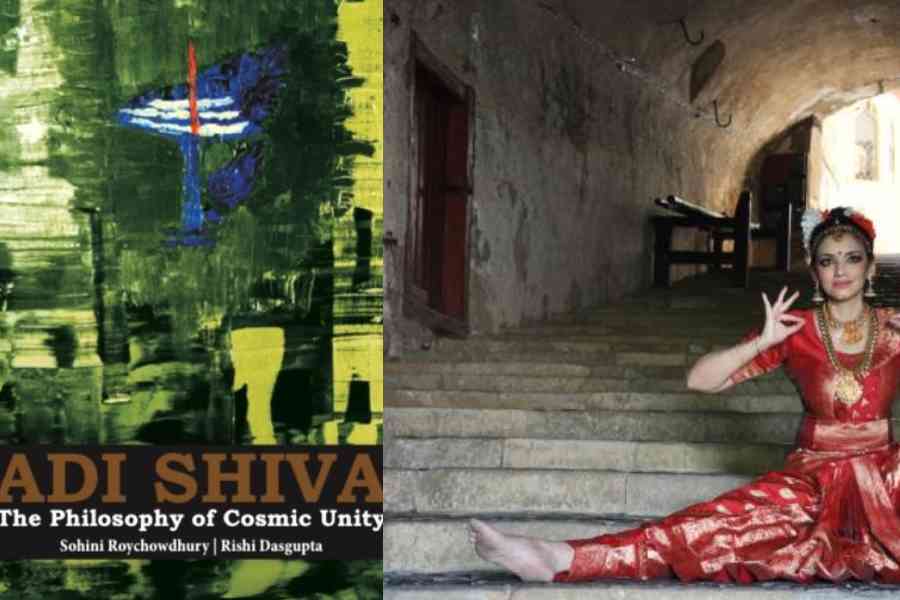Adi Shiva — The Philosophy of Cosmic Unity is my journey from stage to page, exploring the profound influence of Shiva on dance, love and life. An omnipresent central motif in our classical dances, Shiva has always been my muse. In Adi Shiva — The Philosophy of Cosmic Unity, I attempt to embark on a journey of self-discovery and enlightenment, guided by the sheer compassion, empathy and the ‘we are all one’ concept of Shiva. Today, when a third of the world is at war, there are 13 unresolved conflicts globally, Shiva’s philosophy is all about bringing humanity together in compassion, harmony and world peace.
It was necessary for me to decode Shiva from my stage to a book, as I have often been asked who Shiva really is. Especially in the West, where the concept of Shiva is mostly a fuzzy appendage of India exotica, celebrated through selective unthinking motifs on T-shirts, ubiquitous brass Natarajas or puffs of marijuana.
In my book, the Taandav that a lot of us perform on stage, needed to be decoded. Taandav essentially denotes the tears of Shiva, the fire of deep grief, when his consort Sati self-immolates herself in Daksha’s yagna to protest her husband’s insult. Shiva’s Taandav follows, a dance of rage and destruction, till Parvati (Sati reborn) calms Shiva down by singing Raga Malkauns into his ears. Rasa Raudram transforms to Rasa Shantam. We have enacted this several times in our dance operas to enthralled audiences globally, and penning down these backstories rooted in the Puranas was a natural, and the need to round off that journey.
Shiva represents the quintessential divine masculine, a symbol of consciousness, strength and stillness. Shiva’s energy is often invoked to bring about transformation and awakening. He is the ultimate empath, the third-eye, yet another recurring motif in Indian classical dance that symbolises empathy and transcendental vision.
During recent performances on themes of Durga and Kali or Shaktism in general, in Europe, I have been grilled on the suppression of Asian women in society, and the contrasting irony in celebrating these fiery divine alpha women on stage. I found it necessary, therefore, to not only perform the Ardhanareeshwara, but also decode the concept and the ethos for a larger audience through this book. In celebration of their love and oneness, Shiva, in his desire to incorporate Parvati into his own self, relinquished and replaced half of his own being with that of Parvati’s, creating the Ardhanareeshwara. Almost all Indian classical dancers have performed the Ardhanareeshwara on various stages, conveying through their craft the idea that both masculine and feminine aspects are evenly present within an individual. This aspect of Shiva’s philosophy can also be seen as a beacon
for the LGBTQIA+ community, demolishing, as it does, gender biases.
Dance has always been my mode of communication and activism. Through this book, I have, primarily, embarked on a journey of self-discovery as an artist through the prism of Shiva. The book covers a range of exhaustive topics including Shiva and Kali, Shiva’s influence on music, Shiva as Ardhanareeshwara, demystification of the Shiva Linga, Shiva’s offsprings and even Nandi and Bhringi. It is, in essence, an India story, and a stage story, reaching out to a larger audience, and connecting civilisations.
My research assistant and co-author of this book is Rishi Dasgupta. The global launch of the book will be at The Ashmolean Museum, Oxford University, UK, followed by a release event at the Nehru Centre, Indian High Commission, London.
Sohini Roychowdhury is an internationally renowned Bharatanatyam dancer, choreographer, author, speaker, producer, and professor of Natyashastra. She is the founder of Sohinimoksha World Dance & Communications in Madrid, Berlin, Calcutta and New York, and Sohinimoksha Artes de La India in Spain










